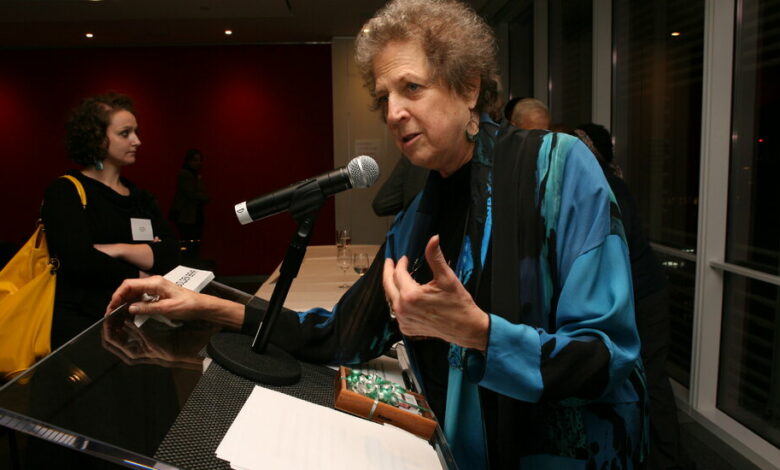Soma Golden Behr, longtime editor of The Times, has died at 84

Soma Golden Behr, a longtime editor at The New York Times who was a centrifuge of story ideas — they flew in every direction — and whose journalistic passions included poverty, race and class, leading to Pulitzer Prize-winning reporting, died Sunday in Manhattan. She was 84.
Her death, in Mount Sinai Hospital’s palliative care unit, came after breast cancer spread to other organs, said her husband, William A. Behr.
Ms. Golden Behr, whose economics degree from Radcliffe led to a lifelong interest in issues of inequality, played a key role in overseeing several major series for The Times examining class and racial divides. Each set involved a squad of reporters and photographers for intensive, sometimes yearlong assignments.
“How Race Is Lived in America,” overseen by Gerald M. Boyd, who would become the paper’s first black editor-in-chief, peeled away the conventional wisdom that the country had become “postracial” by the early 21st century. His deep dive into an integrated church, the military, a slaughterhouse and elsewhere won the paper the Pulitzer Prize for National Reporting in 2001.
Another series, “Class in America,” was a 2005 examination of how social class, often unspoken, created glaring imbalances in society.
And earlier, in 1993, Ms. Golden Behr oversaw a 10-part series, “Children of the Shadows,” that overcame stereotypes about young people in inner cities. The reporter Isabel Wilkerson won a Pulitzer for her poignant portrait in the series about a 10-year-old boy who cares for four siblings.
Ms. Golden Behr was hired by The Times as an economics reporter in 1973 after 11 years at Business Week and was often one of the few women, or the only woman, at the table. She was the first to lead the national desk, appointed in 1987, and after a promotion to assistant managing editor in 1993, she was only the second woman in the newsroom to appear on the masthead.
“At 5 feet 9 inches tall, she could fill almost any room and rarely had to worry about men talking over her, giving her an advantage over many women at The Times,” Adam Nagourney wrote in “The Times,” a 2023 book about the newspaper’s contemporary history.
Mr. Nagourney described her as “cerebral, contemplative and explosive, all at once,” and quoted her in an interview: “I’m a word salad; I explode a lot.”
Jonathan Landman, a former deputy editor of The Times, who plucked Ms. Golden Behr from the copy table to edit national correspondents, said her style was markedly different from that of other bureau chiefs.
“She wasn’t an editor who said we need x to write y,” he said. “She would say, ‘We need to think about housing!’ What followed were interesting conversations and memos, and she got people thinking thematically in ways that were different. It was something.”
Although Ms. Golden Behr was a pioneer and mentored other women at the newspaper, she did not see herself as an ideological feminist.
In 1991, during her tenure as national editor, the paper came under heavy fire for a profile of a young woman who accused William Kennedy Smith, a nephew of Senator Edward M. Kennedy, of rape. Critics inside and outside the newsroom accused the paper of voyeurism and of shaming the woman by quoting a friend who said she was “a little wild.”
At a contentious editorial board meeting, Ms. Golden Behr defended the article. “I’m shocked by the depth of the reaction,” she said, adding, “I can’t explain why there are so many weirdos who read The New York Times.”
Soma Suzanne Golden was born on August 27, 1939, in Washington, DC, the eldest of three children of Dr. Benjamin Golden, a surgeon, and Edith (Seiden) Golden.
She graduated with a BA from Radcliffe College and an MS from Columbia’s Graduate School of Journalism. In 1974, she married Mr. Behr, a social worker and psychoanalyst. The couple lived in Manhattan and Hopewell Junction, NY
Steven Groenhuisa former business and labor reporter at The Times, recalled that when Ms. Golden Behr was lured in 1973 from Business Week, where she was chief economics writer in Washington, it was seen as a coup.
“The coup then became even bigger, Soma was a star who was a woman,” Mr. Greenhouse. “She was extremely respected in the economy.”
Four years later, Mrs. Golden Behr was appointed to the editorial board, the only woman to write exclusively editorials, often on women’s issues, gay rights and inequality.
“After a couple of years she said something like, ‘I don’t know if I have an opinion anymore, I’ve said it all,'” Mr. Behr recalled. She went on to edit the Sunday Business column for five years.
In addition to her husband, she is survived by her daughter, Ariel G. Behr, who works for a nonprofit that funds affordable housing; her son, Zachary G. Behr, an executive at the History Channel; four grandchildren; and a sister, Carol Golden.
When Ms. Golden Behr retired from journalism in 2005, she became director of the New York Times College Scholarship Program, which paid four years of expenses for students who excelled academically despite difficult circumstances such as homelessness.
When funding was cut, Ms. Golden Behr and a partner, Melanie Rosen Brooks, created a similar independent program in 2010, Stock Exchange Plus – an extension of Ms Golden Behr’s desire to tackle inequality. Scholarship Plus, funded by donors, supports 20 students from poor backgrounds each year and supplements their university’s financial aid so they can avoid student loans, in an effort to put its scholars on an equal footing with affluent peers.
Ms. Golden Behr sometimes missed the camaraderie of the newsroom. She invited journalists she had worked with over the years—all women—to her home on the Upper West Side. Until the pandemic put a stop to the gatherings, as many as 30 women would attend, from as far away as Boston.




